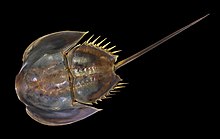Chelicerata
The Chelicerata are a sub-phylum of the Arthropods. The sub-phylum consists of only two classes: the Arachnids and the Merostomata.
| Chelicerata Temporal range: late Ordovician
445 mya to present (see text) | |
|---|---|

| |
| Horseshoe crab | |
| Scientific classification | |
| Kingdom: | |
| Phylum: | |
| (unranked): | |
| Subphylum: | Chelicerata
|
| Classes | |
| |

The Merostomata are the extinct Eurypterids and the horseshoe crabs (Xiphosura). The horseshoe crabs are a small, ancient group which has survived relatively unchanged for millions of years. Groups like this are often called living fossils. The Arachnida is the huge and successful terrestrial (air-breathing) group of spiders and their relatives.
The chelicerates originated as marine animals. The first confirmed chelicerate fossils, the eurypterids, date from 445 million years ago in the late Ordovician period. Although only four marine species survive, all of them horseshoe crabs, there are over 77,000 species of air-breathing chelicerates, and there may be about 500,000 unidentified species.[1][2]
The pycnogonids may or may not be Chelicerates. This is in dispute, as genetic evidence suggests they may be an ancient sister group to all other living arthropods.[3] There are 1,300 species of these 'sea spiders'.
The life-style of chelicerates is largely carnivorous, or other kinds of heterotroph.
References
change- ↑ Margulis, Lynn and Schwartz, Karlene 1998. Five Kingdoms, an illustrated guide to the phyla of life on Earth. 3rd ed, Freeman. ISBN 0-7167-3027-8
- ↑ Ruppert E.E. Fox R.S. and Barnes R.D. 2004. Invertebrate Zoology 7th ed, Brooks/Cole.
- ↑ Regier J.C.; et al. (25 February 2010). "Arthropod relationships revealed by phylogenomic analysis of nuclear protein-coding sequences". Nature. 463 (7284): 1079–1083. Bibcode:2010Natur.463.1079R. doi:10.1038/nature08742. PMID 20147900. S2CID 4427443.
our phylogeny [...] only marginally favoured Chelicerata over the alternative of a more basal placement of Pycnogonida